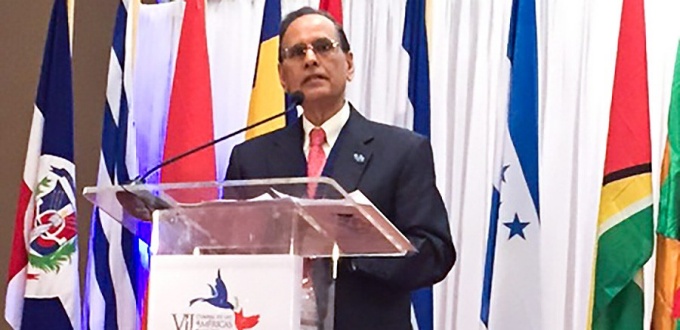Summit of the Americas: The Role of Universities in Regional Economic Development
Published April 10, 2015 This content is archived.

UB President Satish K. Tripathi spoke in Panama at the April 10, 2015 Summit of the Americas on the role of universities in regional economic development.
Good afternoon! I am very pleased to have the opportunity to join with all the distinguished university leaders here today in discussing the role of universities like ours in guiding and sustaining the economic development of our surrounding regions.
This is a subject that is very close to my heart, speaking both as President of a large American public research university, and as a co-leader of our region’s economic development council.
I am proud to help guide a regional council that I think is in many ways a model of a regional economic development strategy that stems from the productive dialogue and collaboration of government, business and industry, and academia.
Three years ago, New York State Governor Andrew Cuomo established a system of 10 Regional Economic Development Councils across the state.
Each is co-chaired by a higher education leader, and a business leader—recognition of the key leadership of higher education institutions as catalysts for economic vitality.
We began, as all successful plans must, with a clearly defined plan based upon a shared vision. Our vision: to create a vibrant region that is a worldwide destination for people to live, learn, work, and visit, and for entrepreneurs and businesses to invest time and capital.
We carefully assessed our economic climate. And we took a close and honest look at our strengths and challenges. In terms of strengths, we knew we benefited from our people and our talent, including 22 area universities and colleges that provide a powerful source of creativity and intellectual capital, and a highly skilled workforce. We also benefited clearly from our established strength in key industry sectors; our regional assets, including natural resources, our geographic situation on an international border, and a rich arts and cultural scene.
These are powerful assets. But we also faced powerful challenges, including a disappearing manufacturing and industry base, population loss over several decades, the lack of a long-term funding strategy, and the lack of a coherent, collaborative strategy—we saw many economic development efforts, but they were working in isolation of each other, rather than pulling in the same direction.
To maximize our strengths and mitigate our liabilities, we focused on defining our core investment sectors—based both on proven success and potential growth. We looked for projects that were collaborative, high-impact, feasible, and sustainable over the long-term. On the basis of these priorities, we identified 8 key industry sectors, including: health and life sciences; higher education; advanced manufacturing; tourism; bi-national logistics; energy; agriculture; and professional business services.
Together, we created a plan that not only imagined what our region could become, but created a pathway to make it so. Our region’s plan became a statewide model. And our work paved the way for a historic billion dollar investment from the Governor.
Let me fast forward to the present day. Today we in Western New York see and live in a region that has been transforming in front of our eyes. We are experiencing a period of unprecedented state investment. And as a result, many spheres are coming into alignment at once.
Not by coincidence, these map closely to the strategic industry sectors we identified in our planning process: healthcare and life sciences; advanced manufacturing; IT; arts and culture.
They also closely mirror our university’s defining strengths, and those of our fellow higher education institutions in the region. Now, after decades of “brain drain,” our region is home to one of the nation’s fastest growing populations of college graduates. We are increasingly a magnet for entrepreneurs, artists, and innovators who recognize the energy gathering in our city.
As just one example, UB is a key leader in a statewide economic development program called START-UP NY, which allows SUNY campuses to designate tax-free zones to foster economic growth. UB’s leadership in this venture has attracted dozens of new companies to our region—including global companies like Aesku.Diagnostics, a German life sciences company; and BAK, a Danish maker of tablet PCs that is relocating its global headquarters to Buffalo.
All this progress is literally changing the skyline of Buffalo. And it all began with the planning process I’ve described.
This is one example of an effort to generate economic development. Today, we’re here to talk about a more difficult, but just as critical, question. That is: now that we have built momentum, how do we sustain it?
As I think the REDC experience demonstrates, sustaining economic development must be a multi-dimensional, collaborative effort. It must be guided by a shared vision for the direction of the region and advanced through dialogue and partnership of business and industry, government and community organizations, health care partners, research and technology enterprises, and especially, higher education institutions.
I say “especially” because I believe that no entity is better positioned to guide this dialogue than our world’s great higher education institutions. But let's also remember that higher education institutions, on their own, cannot transform their respective economies. Higher education is a critical actor, not the sole actor, in our region's economic eco-system.
I look forward to learning more from you today as we talk further about our shared goals, and distinctive experiences, as global universities that have a powerful local impact.